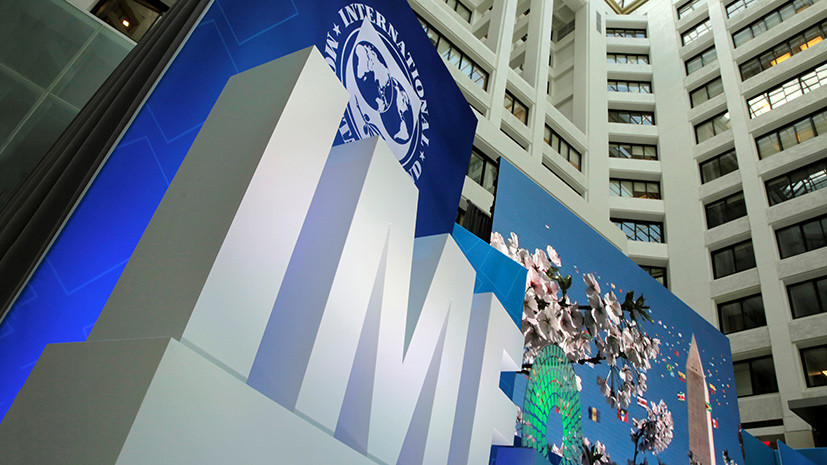The International Monetary Fund lowered its forecast for Russia's GDP growth in 2019 from 1.2% to 1.1%. At the same time, the organization’s experts maintained their assessment for 2020 and are still waiting for the country's economy to accelerate to 1.9%. Such data are contained in the October report of the organization World Economic Outlook, published on Tuesday, October 15.
In many ways, the decrease in the forecast for the growth of Russian GDP is due to the general slowdown in the global economy. But already in 2020, the growth rate may be higher due to the expected implementation of national projects. This was told in an interview with RT by the chief analyst of BCS Premier Anton Pokatovich.
“Hopes for accelerated growth are postponed to 2020, when, perhaps, the state will go on more active spending of budget funds, and national projects will begin to provide real support to the economy,” Pokatovich explained.
In its report, the IMF lowered its forecast for global economic growth in 2019 from 3.2% to 3%. The value is expected to be the lowest in ten years. The forecast for 2020 is also reduced - from 3.5% to 3.4%.
For the fifth consecutive time, fund specialists have worsened their assessment of global economic growth for 2019. The last time the value was reduced in July - from 3.3% to 3.2%. As noted in the IMF itself, the reason for the next revision of the forecast was the aggravation of the trade war between the United States and China.
“The global economy is in a synchronized decline. The forecast for 2019 was again lowered to 3%, the slowest pace since the global financial crisis. This is a serious reduction compared to 3.8% in 2017, when the world economy was in a stage of synchronized recovery. Restrained growth was the result of increasing trade barriers, increased uncertainty regarding trade and geopolitics, ”said IMF Chief Economist Gita Gopinat in a report.
As Kristalina Georgieva, the managing director of the fund, previously stated, tariff wars practically stopped the growth of world trade. As a result, by 2020, the global economy may be missing $ 700 billion.
“For the global economy, the combined effect of trade conflicts could mean a loss of about $ 700 billion by 2020, or about 0.8% of global GDP,” TASS quoted Georgiev as saying.
Recall that the trade war between the United States and China began in 2018. The States accused China of illegally acquiring American technology and increased duties on Chinese goods imported into the country. Beijing has introduced a response. After a series of negotiations in May 2019, Washington went on to aggravate the conflict: in addition to introducing new duties, American technology companies began to stop cooperation with Huawei. In August, countries once again failed to agree on the terms of a trade deal and in September introduced new mutual restrictions.
Following the results of regular negotiations in October, China and the United States were still able to partially agree on the terms of the trade deal. Meanwhile, global investors are still afraid of another exacerbation.
“The trade war has already led to a decrease in the economic activity of enterprises not only in the USA and China, but also throughout the world. The threat of intensification of the conflict and its spread to other countries that are partners of the PRC has created lull and uncertainty in the global market, ”said Artyom Deev, head of the AMarkets analytical department, in an interview with RT.
The situation in world trade is also aggravated by the aggravation of relations between the States and Europe. On October 2, the WTO officially authorized Washington to impose duties on goods and services of the European Union in the amount of $ 7.5 billion.
According to RT analysts interviewed, trade conflicts provoked a sharp decline in business activity in the global industry and services. In September, the corresponding PMI index fell to 51.2 points and remains near a three-year low. This is evidenced by research data from the international investment bank JP Morgan and the analytical agency IHS Markit.
Traditionally, the PMI index reflects the real state of a particular industry. A value above 50 points indicates a positive economic situation, below 50 points - the stagnation of the sector.
“Problems in industry have a high potential for spreading to other sectors of the economy, suppressing overall economic activity. Moreover, trade conflicts are accompanied by growing uncertainty in the business community, which puts significant pressure on both external and domestic demand, ”said Anton Pokatovich.
Amid continuing tensions between Beijing and Washington, IMF experts worsened the forecast for Chinese GDP growth in 2019 from 6.2% to 6.1%, and in 2020 - from 6% to 5.8%.
According to IMF experts, the general economic slowdown may, in addition to China, also affect noticeably all other developing economies. Compared with the July forecast for 2019, expectations for GDP growth in developing countries were worsened from 4.1% to 3.9%. Most notably, the fund lowered its estimate for India - from 7% to 6.1% and for Mexico - from 0.9% to 0.4%.
It is expected that developed economies will also be influenced by the general trend. So, the rate of increase in US GDP for 2019 was reduced from 2.6% to 2.4%, and the eurozone - from 1.3% to 1.2%. The overall growth assessment of the economies of developed countries was deteriorated from 1.9% to 1.7%.

